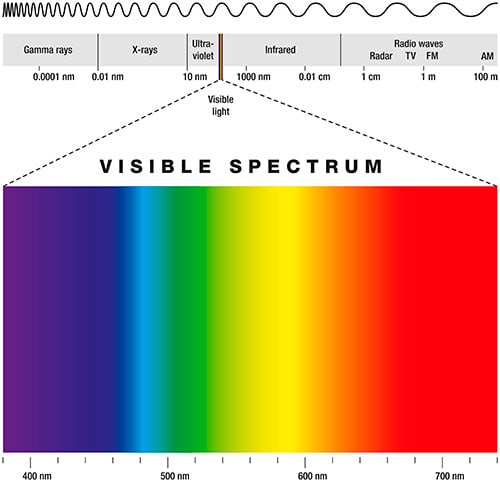
After myriad false alerts, it appears there may actually be some light at the end of the tunnel. We’re talking here about the tunnels leading from the burrows where many of us have spent a restless 15-month hibernation.
But after all the extra time spent in front of screens, one must wonder: does all that blue light threaten our eye health?
What is the electromagnetic spectrum?
The electromagnetic spectrum (EMS) ranges from gamma rays to radio waves. X-rays, ultraviolet rays, infrared rays, and microwave rays are all intermediate portions of the electromagnetic spectrum.
A relatively small segment of the EMS, located in its approximate middle, is known as the visible light spectrum. As the name suggests, these light rays are the only wavelengths that are visible to human vision.
The wavelengths of visible light are between 400 and 750 nanometers (nm). Those waves are very, very short; a nanometer is 1 billionth of a meter. A human hair is about 100,000 nanometers wide.
What is blue light?
Each individual wavelength within the spectrum of visible light is representative of a particular color.
Light at the lower end of the visible spectrum, with a longer wavelength (about 750 nm) is seen as red, light in the middle of the visible spectrum is seen as green, and light with the shortest waves in the visible spectrum (about 400 nm) is seen as violet.
Light waves of 450 to 495 nm are seen by human eyes as variations of the color blue.
Some folks are saying blue light is hazardous to our eyes
Those same people are trying to sell us blue light computer glasses.
During our pandemic hibernations, a lot of us have spent a lot of time looking at screens, such as TVs, computers, smartphones, tablets, e-readers, video games, and more.
It’s incontrovertible that the coronavirus lockdowns have caused us to spend significantly more time looking at digital screens.
It follows that our corneas and retinas are being exposed to more blue light. But those digital screens also emit all the other wavelengths of visible light. So, all of that additional screen time simply means that our eyes are being exposed to more light, composed of many colors.
Is blue light bad for our eyes?
Blue light is everywhere. At least 25% of the sunlight we receive on a clear day is blue light. That’s about the same blue light ratio as in the emission spectrum from a smartphone.
Blue light has the shortest wavelength in the visible light spectrum, and the shorter the length of an electromagnetic wave, the higher the energy it carries. But there is no evidence that blue light itself, whether from the sun or from a digital screen, conveys any special threat to our eye health.
What is digital eye strain?
All of that staring and squinting at screens for long periods of time has led to the proliferation of a condition known as either “digital eye strain” or “computer vision syndrome”. For the sake of simplicity, we’re going with digital eye strain (DES).
What are the symptoms of digital eye strain?
Digital eye strain is characterized by a constellation of symptoms including eye fatigue, ocular irritation, burning, eye strain, dry eyes, redness, and double or blurry vision.
Entrepreneurial entities have nimbly capitalized on the widespread incidence of DES to market blue-light-blocking glasses. They are quick to blame the symptoms of DES on an excessive amount of blue light exposure. And they are equally prompt in the provision of solutions: a new pair of glasses equipped with “blue light lenses” or a “blue light filter” that fits over the offending screen.
The AAO statement on blue light eyeglasses
In response to this marketing blitz by the makers of blue light blocking devices, both the American Academy of Ophthalmology (AAO) and the College of Optometrists have cited a lack of scientific evidence that blue filtering glasses are effective in relieving the symptoms of DES. Each of these authoritative organizations has therefore issued a statement advising against their use.
Instead of adopting special blue light eyeglasses, the AAO advises a more effective course of eye care. If you’re experiencing the symptoms of digital eye strain, get an eye exam from your ophthalmologist. This will provide a precise diagnosis and rule out any serious eye disease.
Then see your optometrist, to make sure that your eyewear or contact lens prescription is currently appropriate.
When you’re reading, whether paper or an e-reader, hold the material at arm’s length. If your eyes get dry, use artificial tears or eye drops.
And alleviate eye strain by following the 20–20–20 protocol. Every 20 minutes, disrupt the you/screen connection by focusing on something at least 20 feet away for at least 20 seconds.
What is circadian rhythm?
Your circadian rhythm is the natural physiological mechanism that modulates your sleep cycle. It is controlled by the release of melatonin, a sleep-inducing hormone produced by the pineal gland. Typically, melatonin emission starts to increase around sunset. It peaks in the middle of the night and gradually diminishes as morning approaches.
The effects of too much blue light can mess with your circadian rhythm
Any visible light waves, but especially the shorter, more energetic waves of blue light, suppress the secretion of melatonin. In a study comparing the effects of 6.5 hours of blue light exposure to green light exposure of the same duration and brightness, the blue light suppressed melatonin for about twice as long as the green light did. The blue light exposure also doubled the shift in circadian rhythms (3 hours for blue light versus 1.5 hours for green light).
Do blue light glasses help you sleep better?
Maybe. But to preserve your natural sleep patterns, simply avoid electronic screens of any type for two hours before retiring. If you really want, or really need, to snuggle up to a computer screen in those two pre-snooze hours, you may have discovered the sole appropriate time to use glasses that block blue light.
Why choose Assil Gaur Eye Institute for your eye care?
At AGEI, you will experience a state-of-the-art health care facility that brings together revolutionary technologies with experienced vision care professionals. Our goal is to help you achieve your personal best vision.
Please call 866-945-2745 or visit us here to make an appointment online. If you are experiencing any concerning symptoms, contact us immediately to determine the best time to schedule an exam.
At Assil Gaur Eye Institute we take our patients’ safety seriously. Our facility’s Covid-19 patient safety procedures exceed all CDC recommendations during this coronavirus pandemic. Masks are required in our institutes at all times.
We are conveniently located for patients throughout Southern California and the Los Angeles area at locations in or near Beverly Hills, Santa Monica, West Los Angeles, West Hollywood, Culver City, Hollywood, Venice, Marina del Rey, Malibu, Manhattan Beach, and Downtown Los Angeles.
- Why is My Iris Inflamed? When to See a Doctor for Iritis - 12/01/2023
- How Your Vision Changes in Your 40s and 50s - 10/17/2023
- Winter Dry Eye Care Tips - 11/02/2021














